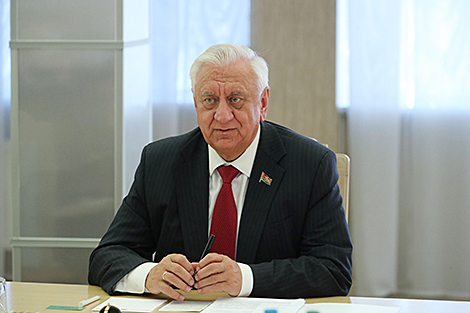Opinions & Interviews
Myasnikovich: Transition to Russian ruble under discussion in EAEU

Mikhail Myasnikovich. An archive photo
MINSK, 28 February (BelTA) – Members of the Eurasian Economic Union (EAEU) keep discussing possible transition to the Russian ruble as the common payment instrument in mutual transactions, Chairman of the Board of the Eurasian Economic Commission Mikhail Myasnikovich told the Belarus 1 TV channel on 27 February, BelTA has learned.
“This matter is high on the agenda, though the approach to it is often opportunistic,” Mikhail Myasnikovich said. In his words, the EAEU financial market is not developed enough. Mikhail Myasnikovich is set to meet with the heads of the central banks of all the participating states to discuss current issues, including the common currency. However, it remains unclear whether this will be the Russian ruble. “All the EAEU member states have a trade deficit with the Russian Federation. They lack Russian ruble revenues to pay for imports from Russia,” Mikhail Myasnikovich explained. “We have to sell something to third countries in order to get foreign currency that can be later converted to Russian rubles needed to trade in the ruble zone,” he added.
“There should not be any financial panic. No one is saying that someone will switch to the Russian ruble tomorrow. We need to think of ways to reduce dollar dependency. At the same time we should not create new problems while trying to address existing challenges,” Mikhail Myasnikovich said.
The EAEU will keep streamlining its financial institutions, like the Eurasian Bank for Reconstruction and Development, the Eurasian Stabilization and Development Fund. After all, the EAEU has set an ambitious task to make it to the world’s five biggest economies.
There are plans to give a bigger focus to investment. “Today the EAEU’s investment accounts for 2.5% of the global investment. We need to grow investment up to at least 25% of GDP or even 30% of GDP,” Mikhail Myasnikovich emphasized. Investment should give rise to new businesses. This, in turn, will help expand the output. “About 20% of trade in the EAEU is trade in mineral resources and raw materials. The share of finished products is growing, but there are few competitive products. We need to increase the number of competitive products that could be sold inside the union and in third countries,” he said.
Mikhail Myasnikovich deems it necessary to establish a Eurasian arbitration. “It is not right when economic entities take their disputes to London, Stockholm and other capital cities. We need to have a full-fledged arbitration of our own,” he said.
These and other tasks were formalized in the 2025 strategy. The first discussion of this comprehensive document might take place at the session of the Eurasian Intergovernmental Council in Minsk on 9-10 April.
Mikhail Myasnikovich emphasized the importance of the equality principle that should prevail in the work of the EAEU. “It is understandable that big economies set the pace and are the pillars of the union. However these pillars should be attractive not only to the participating states, but also to onlookers who are considering membership in this organization. When one sees that disputes inside the union are not resolved and even pile up, no one will want to enter such a union. Yet I have grounds to be optimistic, because the leaders of the states that I visited reaffirmed their commitment to greater integration,” Mikhail Myasnikovich said.







 print version
print version make home page
make home page add to bookmarks
add to bookmarks

